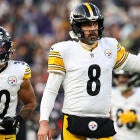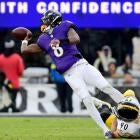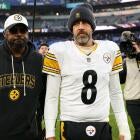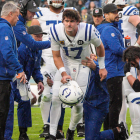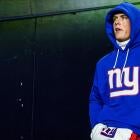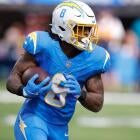Justin Fields trade: How contract, timing boxed Bears into smaller return than Steelers got for Kenny Pickett
Fields has one year left on his rookie contract, and the Bears chose the wrong time to make the trade

Late on Saturday evening, the Chicago Bears clarified their quarterback situation, sending a clear signal that they will be taking a quarterback with the No. 1 overall pick in this year's draft by dealing incumbent starter Justin Fields to the Pittsburgh Steelers for a conditional sixth-round pick that can become a fourth-rounder if Fields plays 51% of the Steelers' offensive snaps next season.
One of the most common immediate reactions to the trade was to question how the Bears managed to get so little in return for Fields, who has struggled with inconsistency as a passer but has at least flashed high-level upside on occasion, and who has emerged as one of the premier rushing threats at the position. With Fields still just recently turning 25 years old, it's hard to believe there wasn't a more significant market for his services.
But according to ESPN, Chicago had sought a return similar to the one Sam Darnold fetched when he was traded to Carolina in 2021 (a sixth-round pick in 2022, plus second- and fourth-rounders in 2022) and instead ended up settling for merely a conditional Day 3 selection. Meanwhile, the Steelers traded their own incumbent starter, Kenny Pickett, to the Philadelphia Eagles along with a fourth-round pick in this year's draft, receiving a third-rounder and two 2025 seventh-round picks in return.
By just about any reasonable measure, the Steelers got more for Pickett than the Bears did for Fields, despite Pickett's having shown precious little outside of the preseason that would leave one to believe that he has the requisite skill set or upside to be an NFL starter.
There are a couple factors that contributed to this. The first is the players' respective contracts. It seems clear that the market for both players treated them as backup quarterbacks. Apparently, nobody was all that interested in having Fields be their starter next season.
So, in essence, teams would be trading for a backup QB who only has one year left on his cheap, rookie-scale contract, which will pay him approximately $3.2 million for the 2024 season. Pickett has two cheap years left, totaling $4.6 million. If you're trying to acquire a backup on the cheap, it's better to be able to keep his costs down for two years than for merely one.
The team acquiring Fields also has the right to pick up his fifth-year option for the 2025 campaign, but that's going to run around $25.7 million, so it's highly unlikely that any team would be picking it up. So, with Fields, it's one cheap year, and then he's a free agent and you either have to pay him, or let him leave. That contributes to a smaller return.
But that brings us to the second contributing factor: timing. There were several windows throughout this offseason during which the Bears could have traded Fields: pre-free agency; during or after the first wave of free agency (i.e. now); during the draft; after the draft; or during training camp.
Getting a deal before free agency would have given the Bears a first-mover advantage, because the other backup and starting quarterbacks had yet to be signed or traded. They could have set the market. Now that players like Kirk Cousins, Darnold, Marcus Mariota, Gardner Minshew, Drew Lock, Tyrod Taylor, Pickett, Desmond Ridder, and Sam Howell have all changed squads, most teams think they have their quarterback situations pretty much set. The ones that don't, figure they are going to land a QB in the draft.
That's why waiting until the draft could have also helped the Steelers increase their return. Not every team that wants a quarterback in the draft is likely to have things break their way. If one team or another got shut out of the market, they could have turned their eyes on Fields instead. And of course, anything -- including injuries -- can happen during training camp, and all of a sudden, you might be able to trade Fields for considerably more, to a team that loses its starter. (See: Sam Bradford to the Minnesota Vikings in 2016.)
But instead, knowing that teams viewed Fields in this moment as merely a backup quarterback, the Bears chose to trade him during the one window at which he was almost certain to be the nadir of his value this offseason.











